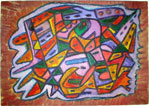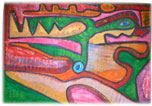Welcome to: Oil Painting Gallery
Oil on Canvas, on board, on acid free paper, on wood cut...
Oil painting
Oil painting is the process of painting with pigments that are bound with a medium of drying oil - especially in early modern Europe, linseed oil. Often an oil such as linseed was boiled with a resin such as pine resin or even frankincense; these were called 'varnishes' and were prized for their body and gloss. Other oils occasionally used include poppyseed oil, walnut oil, and safflower oil.
These oils confer various properties to the oil paint, such as less yellowing or different drying times. Certain differences are also visible in the sheen of the paints depending on the oil. Painters often use different oils in the same painting depending on specific pigments and effects desired. The paints themselves also develop a particular feel depending on the medium.
History
Oil painting dates in the West to at least ancient Roman times. Recent research supports the likelihood that it spread to Asia between the fifth to ninth century.Surfaces like shields - both those used in tournaments and those hung as decorations - were more durable when painted in oil-based media than when painted in the traditional tempera paints.
Most Renaissance sources, in particular Vasari, credited northern European painters of the 15th century, and Jan van Eyck in particular, with the "invention" of painting with oil media on wood panel, however Theophilus (Roger of Helmarshausen) clearly gives instructions for oil-based painting in his treatise, On Divers Arts, written in 1125. Early Netherlandish painting in the 15th century was however the first to make oil the usual painting medium, followed by the rest of Northern Europe, and only then Italy.
The popularity of oil spread through Italy from the North, starting in Venice in the late 15th century. By 1540 the previous method for painting on panel, tempera had become all but extinct, although Italians continued to use fresco for wall paintings, which was more difficult in Northern climates.
Oil painting Techniques
Traditional oil painting techniques often begin with the artist sketching the figure onto the canvas with charcoal or a "wash," which is thinned paint. Oil paint can be mixed with turpentine or artist grade mineral spirits or other solvents to create a thinner, faster drying paint. Then the artist builds the figure in layers.
A basic rule of oil paint application is 'fat over lean.' This means that each additional layer of paint should be a bit oilier than the layer below, to allow proper drying. As a painting gets additional layers, the paint must get oilier (leaner to fatter) or the final painting will crack and peel.
There are many other painting media that can be used in oil painting, including cold wax, resins, and varnishes. These additional media can aid the painter in adjusting the translucency of the paint, the sheen of the paint, the density or 'body' of the paint, and the ability of the paint to hold or conceal the brushstroke. These variables are closely related to the expressive capacity of oil paint. When looking at original oil paintings, the various traits of oil paint allow one to sense the choices the artist made as they applied the paint. For the viewer, the paint is still, but for the artist, the oil paint is a liquid or semi-liquid and must be moved 'onto' the painting surface.
Traditionally
Traditionally, moving paint was accomplished with paint brushes, but there are other methods, including the palette knife, the rag, and even directly from the paint tube. Oil paint remains wet longer than many other types of artists' materials, enabling the artist to change the color, texture or form of the figure.
At times, the painter might even remove an entire layer of paint and begin anew. This can be done with a rag and some turpentine for a certain time while the paint is wet, but after a while, the hardened layer must be scraped. Many oil paintings reveal evidence of such scraping on close inspection, particularly when the surface itself is examined.
Oil paint dries by oxidation, not evaporation, and is usually dry to the touch in a day to two weeks. It is generally dry enough to be varnished in six months to a year. Art conservators do not consider an oil painting completely dry until it is 60 to 80 years old. more
A.K.A.'S Inspiration Art for all
This is the site where we gladly share our styles and techniques with everyone.






